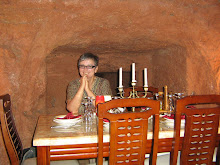
The photo shows a small part of the Tarxien temple complex that is made up of four temple units and a square court. Like Kordin 3 that I described in the previous post, the site has been built up all around so it has lost some of the drama of the temples sited on the south western cliffs. The most dramatic archaological finds were unearthed here and now grace the Museum of Archaeology in Valletta but replicas remain on site and some restoration work has been carried out so visitors can gain some impression of what the temple might have looked like.
Many of the slabs found here by a Maltese archaeologist, Sir Temi Zammitt, who excavated the site from 1915, were decorated with swirls and dots carved into the softer limestone blocks. This was also where the huge statue of the goddess was found, or at least the lower half of her since the top half had long ago been sacrificed to farmers' ploughs and temple desecration. A decorated sacrificial altar was also located with a small cupboard cut in at the base containing a sacrificial knife.
The Tarxien temple site yielded a great deal of information that enabled archaeologists to build a time frame of the pre-history of Malta and Gozo. The four temples had been added or altered at various phases and sherds of pottery and later metal enabled dating from the temple period through to the bronze and iron age and much later still the Punic/Roman phase. Previously, the Maltese temples had been attributed to about 1000BC. Now archaeologists started to talk in terms of earlier sites from 5000BC. In a previous post, I talked about the bones of Ghar Dalem and this site has given its name to the first period of neolithic pre-history. Tarxien enters the picture before 3000BC.
From this first day of visits to the temples at Kordin 3 and Tarxien I also started to understand a little more about the construction of the roofs of the temples. It seems there are two theories about how the buildings were covered and both methods may have co-existed on different sites depending on the type of limestone used in the construction of the walls. One method was the stone built vault used when the more easily shaped softer limestone was used. The other was rafters with brushwood and clay used with harder rubble walls. Small, beehive shaped, rubble roofed buildings can still be seen in some of the fields in Malta and of course the softer limestone is still used extensively in house building and shapes the nature of the Maltese landscape. There is a tourist venue called the Limestone Experience where the story of Malta's cultural association with limestone is told and I have promised myself a visit there soon.
My next post will be about my visit to the Ggantija temples on Gozo.

No comments:
Post a Comment